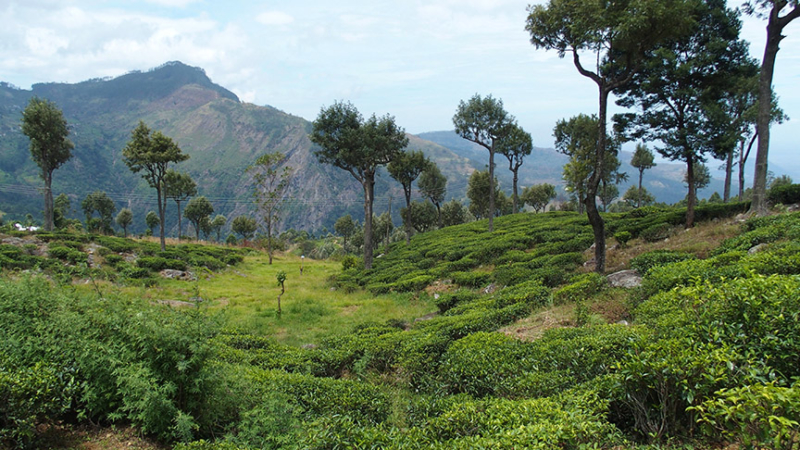The town of Ella, as beautiful as it may be, left us with a very unpleasant feeling. We got out of there pretty quickly but decided to go to another small mountain town that was a bit more out of the way – Haputale. We could actually reach it by a short and pleasant train ride and its surrounding environment is every bit as beautiful as Ella’s but Haputale isn’t a major tourist destination, yet. People are starting to put up guesthouses, probably lured by the money they see flowing into their neighboring town of Ella but for now it’s very low key. It sits on the top of a narrow ridge, with amazing views off to both sides. On one side there’s a deep green valley with tea plantations and undulating layers of mountains forming the northern horizon. This area is right at the edge of the highlands and, off to the south, the mountains drop steeply to a low plateau. From Haputale we could gaze out to an enormous expanse including the southern flatlands and other mountains that form the edge of the highlands.
There’s not a lot to do in terms of entertainment or flashy tourist attractions in Haputale but still it turned out to be one of our favorite places that we visited in Sri Lanka. The town itself is genuine. It’s not filled with restaurants and bars that were put there specifically for tourists.
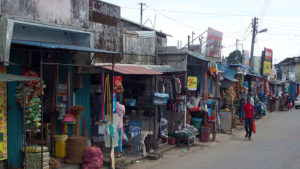
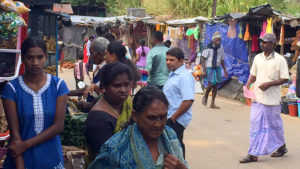
It was also the first place we stayed that was primarily Tamil. Honestly, I don’t know much about the Tamils, except that they originated in southern India and that Sri Lanka had, up until fairly recently, been in a civil war between the Tamils and the Sinhalese which left many parts of the country devastated. Fortunately Haputale isn’t one of those places. On a lighter note, the people of Haputale were relatively friendly and the women, in particular, dressed in a striking traditional manner. Colorful and intricately decorated fabrics were perfectly draped around their bodies and elaborate jewelry completed the ensemble.
The best part of Haputale, however, was what we could see within a day hike from town. One afternoon we packed up some water, stopped to get a bag full of delicious samosas to snack on (I could pretty much live on those things), and took off walking down one of the few roads leading away from the center of things. The road snaked along the edge of the highlands and it felt liberating to depend on our own feet to get us around. It was quiet, the fresh air was cleansing, and the views of the mountainsides and the southern plains were wonderful. We finally got to witness the tea plantations up close and wander through them. Rows of constantly pruned tea bushes cling to the contours of the rocky hills. Stone walls and walkways wind through them in curious patterns, giving workers the ability to easily walk amongst the plants even on very steep slopes. The trunks and roots of the tea plants are thick and toughened with age, and probably prevent the entire area from washing away with the frequent rain. It’s definitely cultivated land but it almost feels wild and the geological skeleton underlying this blanket of green can be seen and felt everywhere.
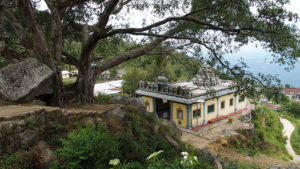
At one point we noticed a small Hindu temple down the hill from the road, tucked under a giant sprawling tree. Sri Lanka’s Hindu temples were new to me and by this time I was starting to develop a certain fascination with them. The colorful sculpted facades and depictions of deities are very unique. Despite their highly ornate quality they can have a humble and quirky energy about them. Some are barely more than roadside shacks, buried in power lines and surrounded by rusted corrugated steel. Strings of flashing lights and neon bulbs sometimes frame the almost psychedelic images inside and give the whole thing the feel of a carnival or a casino. Some are obviously much larger and maintained with a higher budget but even those seem to have odd and sometimes frightening visual surprises around every corner. Of course my appreciation will deepen as I learn more about the religion, and I fully admit that I’m almost completely ignorant about its true nature, but there is one key point that I’ve discovered. There isn’t one form of Hinduism, or two or ten or a hundred. While there may be a fundamental set of common beliefs, the specific practices of worship and very elaborate, shall I say, auxiliary beliefs can vary enormously from town to town, region to region, and country to country. There are countless forms of Hinduism and we encountered some surprising local varieties as we moved around Sri Lanka. Certain temples, and the people who visit them, were completely devoted to deities that other Hindus may have never even heard of. I look forward to learning more about it, especially as we move on into India.
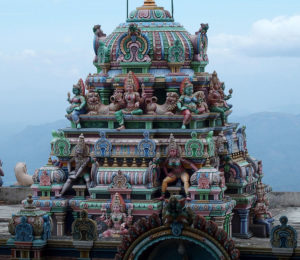
We climbed down the hill to take a closer look at the temple and followed a small path away from it only to find ourselves suddenly entering a very small village. The village was tucked into a tea plantation so I assumed that most of the able bodied people there worked harvesting tea leaves. I can only imagine the number of people, and entire villages, that are completely dependent on tea harvesting for their livelihood. The income level here was extremely low, even by Sri Lankan standards. There were some very nice gardens scattered around but the buildings were extremely basic. There wasn’t really a road that went into the village, just some stairs leading down from the road and a couple of meandering pathways. People washed clothes and bathed in the sun. Children scampered about and definitely noticed us. Some of them tried out their few English phrases on us. Adults looked up and stared at us with red stained teeth from chewing betel nut. We felt as though we might be intruding into their private world and plotted a course back up to the road when an older man came up to us and said hello.
He asked where we were from and what we were doing. To convey our intent to leave and respect their privacy we told him that we were just walking, and that we were heading back up to the road. After slowly clarifying that we were walking, not working, a big smile came over his face and he exclaimed, “Well then, you must come to my home and have some tea!”
I quickly looked at Fern to try and read her reaction and when I didn’t see anything negative in her eyes I told him, “OK, that sounds nice.”
We followed him to his home which was very close, took off our shoes, and followed him inside to sit down on a couch. He sat down across from us, two women appeared, and children started trickling into the small living room. One of the women, dressed in the lovely Tamil style, made sweet milky spiced tea and brought it out to us. The man was in his sixties and due to back problems could no longer work in the tea fields and one of the women was his daughter. One or two of the children were his grandchildren and the others were neighbors. The women didn’t speak much English but the man could get his point across. We talked for a quite a while and snapped some photos of the giggling children who were obviously very intrigued by us. They were absolutely adorable. Despite the fact that the older man couldn’t work any more and his son was having some major health problems, he had a beaming smile. The people of the village took care of each other.
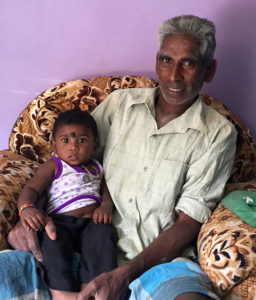
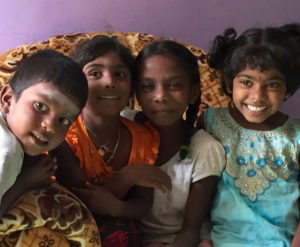
Fern and I were incredibly grateful for this show of hospitality but eventually we felt it was time to move on. With pride in his voice our host pointed out the roofless concrete outhouse and kitchen across the path from his door as we headed outside. One of the ladies spat red betel juice into a drain in the sidewalk which was apparently the place for doing just that, judging by amount of red blotches all around where people had missed the drain. More people stared at us and more children came running up to us to say hi. We slowly worked our way back up to the road and continued on through this gorgeous piece of the earth.
It was a long walk and all of it was very special. The temple, the tea plantations, the village, a small stretch of dense jungle, small farms and gardens, and especially the family we visited. It was incredibly touching that someone with so little material wealth would be so warm and hospitable, especially considering the greed, lies, and constant scamming that we encountered in other places. This friendly man wanted nothing from us except that we should spend some time with him and have a tiny glimpse into his life, and he into ours. Here again was the other side of Sri Lanka. We literally had to walk miles and miles away from a small town in the middle of nowhere to find it but I’m sure glad we did.
In some places one can step right off the bus or plane and incredible experiences await. In others, it takes a little work or it takes enduring some things that may not be so fun. How hard are we willing to try? As travelers do we owe it to a population of people to overlook their nasty side in order to see the good things? We don’t owe them anything but we probably owe it to ourselves to at least try to see things from their perspective. Even so, lines can be crossed, people can push us to the point of not caring, and then someone else comes along who pulls us in the opposite direction with their warm heart. Maintaining a healthy balance between caution and openness is one of the biggest challenges that we face. It requires constant learning and reevaluation depending on the circumstances and I’d like to think that Fern and I are both getting better at it.
jim@snorkelbandits.com

